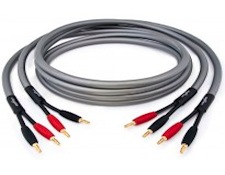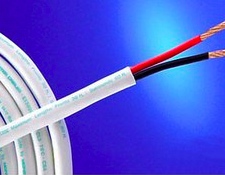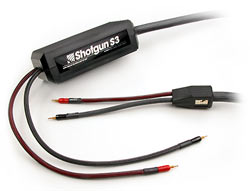It’s the time of year for saving money!
In the first part of this article, I wrote that the way to get the very best cables for free is to go buy a receiver or an integrated amplifier. At least for their own internal inter-function connections, integrated components like those don’t need cables, so because, to my way of thinking, THE VERY BEST CABLE POSSIBLE IS NO CABLE AT ALL, they seem to represent a clear best option.
 Even so, just switching to integrated components still can’t eliminate cable issues entirely: Even the most feature-laden integrated components (like “super-receivers”, for example, that include not only a tuner, a preamp, and an amplifier, but also source components for CDs or DVDs and/or streaming audio) still require AT LEAST speaker cables or (if the speakers are “wireless”) hookup-cables for their transmitters. And, unless the whole “super-component” is battery-powered (which, frankly, I’ve never even heard of) an AC power cable will be needed, too – all of which means that improvements to cables are still not only possible, but probably necessary.
Even so, just switching to integrated components still can’t eliminate cable issues entirely: Even the most feature-laden integrated components (like “super-receivers”, for example, that include not only a tuner, a preamp, and an amplifier, but also source components for CDs or DVDs and/or streaming audio) still require AT LEAST speaker cables or (if the speakers are “wireless”) hookup-cables for their transmitters. And, unless the whole “super-component” is battery-powered (which, frankly, I’ve never even heard of) an AC power cable will be needed, too – all of which means that improvements to cables are still not only possible, but probably necessary.
Before any actual improvement can be done, however, the first thing that has to happen is for the people who will make the “better” cables and the people who will buy and use them to agree on what actually constitutes an “improvement” and on just exactly what the word “better” means ― a task far more difficult than it might at first seem.
The problem, of course, is that different people have entirely different ideas of what a cable is supposed to do: For me, a cable is simply a pipeline for signal, and a “better” cable is one that does less to the signal that’s passed through it, with less stuff being added, less lost or taken away, less distortion and less change of any kind to the signal as it was originally introduced. I and those who believe as I do, think that the perfect cable would be one that, as “the Man in the Street” might say if asked about a cable’s function, just carries signal from Point A to Point B, and does nothing else to it at all. Other people, though, see a cable as a tool for making the signal passed through it “better” (There’s that word again), better sounding, more “musical”, or to tailor it for the particular components that it will run between. They take a position exactly the opposite of mine, and say that cables are, and can and should be used as filters, tone controls, or phase-shift devices, and that they SHOULD play an active and directed role in changing or correcting the sound of the system they’re used in.
 This latter vision of a “better” cable is easy to find and easy for manufacturers to sell, and whether you understand or agree with it or not, you’re probably already familiar with it in the form of the “magic box” cables from MIT (Music Interface Technologies) and Transparent Audio. If I remember correctly, it was MIT that first came out with them, some twenty-five years ago, reasoning that, with all cables already having Resistance (R), Capacitance (C), and Inductance (L), anyway, all are already functioning as filters to affect the frequency and phase characteristics of the signals they carry. That being the case, MIT’s designer, Bruce Brisson, apparently decided not to be satisfied with just the natural filter characteristics of his designs, but, by adding “network boxes” containing additional functioning RCL elements, to optimize his cables as low-pass Butterworth filters “tuned” to their specific applications. One can only assume that Transparent’s boxes are intended for a similar purpose and that they work in much the same way.
This latter vision of a “better” cable is easy to find and easy for manufacturers to sell, and whether you understand or agree with it or not, you’re probably already familiar with it in the form of the “magic box” cables from MIT (Music Interface Technologies) and Transparent Audio. If I remember correctly, it was MIT that first came out with them, some twenty-five years ago, reasoning that, with all cables already having Resistance (R), Capacitance (C), and Inductance (L), anyway, all are already functioning as filters to affect the frequency and phase characteristics of the signals they carry. That being the case, MIT’s designer, Bruce Brisson, apparently decided not to be satisfied with just the natural filter characteristics of his designs, but, by adding “network boxes” containing additional functioning RCL elements, to optimize his cables as low-pass Butterworth filters “tuned” to their specific applications. One can only assume that Transparent’s boxes are intended for a similar purpose and that they work in much the same way.
The idea of “tuning” cables for specific applications, or to work with specific combinations (even to the make and model) of equipment is not exclusive to MIT and Transparent; Ted Denney’s company, Synergistic Research has been claiming to do something like that for as long as I can remember. As to whether it works? I frankly don’t know. All I DO know are three things: The first is that for any company to be able to individually design its products to match the near-infinite number of possible combinations of equipment they could be used with would seem to require near-infinite research and development; would require the building (meaning designing and fabricating) of each and every individual cable to specific order, with neither manufacturer nor dealer in-stock inventory ever possible; and would result in HUGE, though probably NOT “near-infinite” expense for the finished product. The second is that I don’t know of even one cable company that has the facilities or the resources to do the necessary R&D and custom fabrication, or who could charge the necessary prices and still stay in business. And, finally, the third is that signal transmission lines (“cables”, to you) are usually run (except for speaker cables) either impedance-matched or “loaded”. If they’re intended to be matched (as in a 50, 75, 110, or 600 Ohm line with matching input and output impedances) the cables (and connectors) must either match the input and output impedances or there can be problems. And if they are intended to be “loaded”(low output impedance to high input impedance) matching isn’t possible, so that there’s at least one area where cables CAN’T be “tailored” for use with specific equipment. As to the rest of it? Well, yeah, tone controls can work, but so what? And if you buy new equipment, do you really want to have to buy new cables every time?
]]> Other than trying to make cables that will (hopefully) make the signal they pass sound better, about the only other way to use cables to improve the sound of your system is to build cables that will do less damage to the signal that they pass. There are all kinds of ways to do that, and they include using better metal for the conductors (I prefer copper over silver, except for possible digital or video applications); using longer-grain copper (interestingly, fewer crystals per meter, seems to be more important than higher purity); using better construction geometries (Do you know the difference between coaxial and bunched lays? Do you know that “Litz” construction DOESN’T just mean insulating each individual conductor strand? Do you know whether more of fewer strands is better? Do you know why stranding is used at all?); and using better insulating (dielectric) materials (Yeah, Knut, balsa wood IS good [but lumpy and hard to bend], and NO, the rest of you other guys, cotton ISN’T as good as it seems, but I’m not going to tell you why ).
Other than trying to make cables that will (hopefully) make the signal they pass sound better, about the only other way to use cables to improve the sound of your system is to build cables that will do less damage to the signal that they pass. There are all kinds of ways to do that, and they include using better metal for the conductors (I prefer copper over silver, except for possible digital or video applications); using longer-grain copper (interestingly, fewer crystals per meter, seems to be more important than higher purity); using better construction geometries (Do you know the difference between coaxial and bunched lays? Do you know that “Litz” construction DOESN’T just mean insulating each individual conductor strand? Do you know whether more of fewer strands is better? Do you know why stranding is used at all?); and using better insulating (dielectric) materials (Yeah, Knut, balsa wood IS good [but lumpy and hard to bend], and NO, the rest of you other guys, cotton ISN’T as good as it seems, but I’m not going to tell you why ).
Better design and construction of the connectors; whether they’re high or low mass; what they’re plated with; and even whether they’re crimped or soldered-on (or crimped AND soldered) can also lessen the amount of change a cable will impose on the signal it passes and ultimately result in better sound for your system. In fact, there is any number of seemingly little changes to the design of a cable that can result – but only for those who have the ability to hear and the courage to believe the evidence of their own senses ― in an audible and enjoyable improvement in the sound of their system. To my way of thinking, no-cable-at-all is still the very best cable, but where cables can’t be avoided, there ARE things that can be done, and that reputable cable manufacturers DO do to make them sound better, and not necessarily for all that much money. Shop carefully; learn more; TRUST YOUR EARS. It’s worth it!





